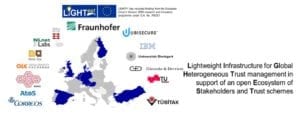A few hours in an airplane provides a great opportunity for spending a few moments on reflecting where the Trust Infrastructure project LIGHTest is heading now
Flying home from a LIGHTest Consortium Meeting in Graz, Austria I’m overwhelmed with the progress that the whole European team has shown.
Some time ago I wrote an introductory blog about this great EU-funded project. So please read that as an intro first if you are unfamiliar with LIGHTest.
As the project is still in a fairly early stage, it is of course a bit early to say anything about the whole level of success in its whole prestigious objective to create principles as foundation and a real implementation on top of that for a global trust infrastructure. And then put that into action. So, quite an objective.
Where are we in the world of interactions
Many issues are still open or underwork and those are of course anyway internal for the project, but that much is clear already, that if the team keeps this pace, there will be success for the bigger whole.
But, as the likelihood that there will be success is increasing as the project proceeds favorably, it is also time to start thinking out loud about what then will happen and the impact of it all.
We live in a world of interactions. Business is based on interactions. The success of any development that brings us forward is based on interactions. As a base for any such successful interaction to take place there must be trust. If you can’t trust your counterpart or stakeholder and the claims he/she presents, then you can’t commit to the interaction with that counterpart. Then the transaction or interaction just won’t happen.
We can’t meet them all, therefore need trust mechanisms and an Infrastructure
Another obvious and critical trend is of course globalization as well as the continuing rapid digitalization of basically everything in our society and in our businesses. And, with on the other hand climate change putting huge pressure on us all to reduce for instance unnecessary travel, we can’t rely on having met every individual or representative of organizations we have to deal with.
So, there must be mechanisms for ensuring that there is enough trust and more importantly verifiable trust, so that all those positive things can happen that are a result of all those many interactions that we are then able to do (because there is that trust).
Something you have… … and something new
Now, luckily some, or actually quite many, building blocks and mechanisms of all that to take place in practice, are already there. So we are already on the way and some things and transactions happen of course every day already today – as we all can experience just by browsing in all what there is on Internet.
But nevertheless, some important mechanisms and infra-structure is still not there as they should be.
Still, each time you order something from a counterpart that you really never have met, you take a risk. Sometimes that risk is just the money that you paid for that whatever thing you ordered from eg an ecommerce site that turned out to be a bad one not to be trusted.
So still, a rogue person or organization can, if they want to and have an incentive to do so, take advantage of the elements still missing from the secure and trustworthy principles and infrastructure we have in place today on the Internet. That’s where LIGHTest comes in.
“Can I have one internet-scale global infrastructure, please?”
What the LIGHTest partners are now putting their resources and efforts in, is to create mechanisms and a properly working internet-scale global infrastructure so that you can in the end really trust that one Mr. Smith is really who he claims to be and that Fantastic Gadget Company Inc. is really who they claim to be.
Because, as said, that still missing infrastructure is to be internet-scale and global, it must be highly automated and must build on partly already existing mechanisms. Otherwise it won’t be feasible and won’t happen.
That’s why LIGHTest took the existing DNSSec as a starting point for its further development. And, like indicated in the beginning, as the development and the achieved results in LIGHTest have so far been quite encouraging, it implies that it just might turn out to have been an excellent choice. Let’s hope so.
The LIGHTest Consortium team will continue to do its development work, finding out more and removing obstacles. Stay tuned.
More about the LIGHTest project:
https://www.lightest-community.org/
https://cordis.europa.eu/project/rcn/203437_en.html

This project has received funding from the European Union’s Horizon 2020 research and innovation programme under G.A. No. 700321



About The Author: Charles Sederholm
More posts by Charles Sederholm